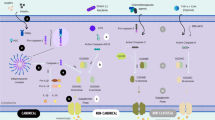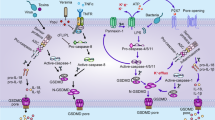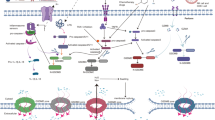Abstract
Pyroptosis is a newly discovered form of programmed cell death mediated by the gasdermin protein, that is accompanied by inflammation and immune response. A growing body of evidence suggests that pyroptosis is closely related to cancer, and it is becoming a new cancer research topic. Studies have suggested that different cancer cells activate pyroptosis in different ways and that the effects of pyroptosis vary in different cancer backgrounds. In this article, we briefly introduce the definition, characteristics, and activation pathways of pyroptosis. Then we review the complex effects of pyroptosis on cancer development, which generally include inhibition of cancer cell viability, impacts on the invasion and migration of cancer cells, improvement of antitumor immunity, and enhancement of chemotherapy sensitivity. We also discuss drugs and compounds that can induce pyroptosis, as well as the interaction between pyroptosis and apoptosis. Elucidating the mechanisms of the complex effects of pyroptosis is likely to pave the way for therapeutic approaches for cancer in the future.




Similar content being viewed by others
Data Availability
The data used for graphing and tabulation in this review are all from references.
References
Hanahan D, Weinberg RA (2000) The hallmarks of cancer. Cell 100:57–70
Hanahan D, Weinberg RA (2011) Hallmarks of cancer: the next generation. Cell 144:646–674
Coussens LM, Werb Z (2002) Inflammation and cancer. Nature 420:860–867
Zhao H, Wu L, Yan G et al (2021) Inflammation and tumor progression: signaling pathways and targeted intervention. Signal Transduct Target Ther 6:263
Cookson BT, Brennan MA (2001) Pro-inflammatory programmed cell death. Trends Microbiol 9:113–114
Wang X, Li H, Li W et al (2020) The role of Caspase-1/GSDMD-mediated pyroptosis in Taxol-induced cell death and a Taxol-resistant phenotype in nasopharyngeal carcinoma regulated by autophagy. Cell Biol Toxicol 36(5):437–457
Chen Z, Xu G, Wu D et al (2020) Lobaplatin induces pyroptosis through regulating cIAP1/2, Ripoptosome and ROS in nasopharyngeal carcinoma. Biochem Pharmacol 177:114023
Jiang C, Shi R, Chen B, Yan X, Tang G (2020) Casticin elicits inflammasome-induced pyroptosis through activating PKR/JNK/NF-κB signal in 5–8F cells. Biomed Pharmacother 123:109576
Cheng R, Billet S, Liu C et al (2020) Periodontal inflammation recruits distant metastatic breast cancer cells by increasing myeloid-derived suppressor cells. Oncogene 39:1543–1556
Ringel-Scaia VM, Beitel-White N, Lorenzo MF et al (2019) High-frequency irreversible electroporation is an effective tumor ablation strategy that induces immunologic cell death and promotes systemic anti-tumor immunity. EBioMedicine 44:112–125
Pizato N, Luzete BC, Kiffer LFMV et al (2018) Omega-3 docosahexaenoic acid induces pyroptosis cell death in triple-negative breast cancer cells. Sci Rep 8:1952
Lu C, Guo C, Chen H et al (2020) A novel chimeric PD1-NKG2D-41BB receptor enhances antitumor activity of NK92 cells against human lung cancer H1299 cells by triggering pyroptosis. Mol Immunol 122:200–206
Yu P, Wang H-Y, Tian M et al (2019) Eukaryotic elongation factor-2 kinase regulates the cross-talk between autophagy and pyroptosis in doxorubicin-treated human melanoma cells in vitro. Acta Pharmacol Sin 40:1237–1244
Erkes DA, Cai W, Sanchez IM et al (2020) Mutant BRAF and MEK inhibitors regulate the tumor immune microenvironment via pyroptosis. Cancer Discov 10:254–269
Zhou B, Zhang J-Y, Liu X-S et al (2018) Tom20 senses iron-activated ROS signaling to promote melanoma cell pyroptosis. Cell Res 28:1171–1185
Ren N, Jiang T, Wang C et al (2020) LncRNA ADAMTS9-AS2 inhibits gastric cancer (GC) development and sensitizes chemoresistant GC cells to cisplatin by regulating miR-223-3p/NLRP3 axis. Aging (Albany NY) 12:11025–11041
Wang L, Li K, Lin X et al (2019) Metformin induces human esophageal carcinoma cell pyroptosis by targeting the miR-497/PELP1 axis. Cancer Lett 450:22–31
Yu J, Li S, Qi J et al (2019) Cleavage of GSDME by caspase-3 determines lobaplatin-induced pyroptosis in colon cancer cells. Cell Death Dis 10:193
Derangère V, Chevriaux A, Courtaut F et al (2014) Liver X receptor β activation induces pyroptosis of human and murine colon cancer cells. Cell Death Differ 21:1914–1924
Hage C, Hoves S, Strauss L et al (2019) Sorafenib induces pyroptosis in macrophages and triggers natural killer cell-mediated cytotoxicity against hepatocellular carcinoma. Hepatology (Baltimore, MD) 70:1280–1297
Wei Q, Zhu R, Zhu J, Zhao R, Li M (2019) E2-induced activation of the NLRP3 inflammasome triggers pyroptosis and inhibits autophagy in HCC cells. Oncol Res 27:827–834
Cui J, Zhou Z, Yang H et al (2019) MST1 suppresses pancreatic cancer progression via ROS-induced pyroptosis. Mol Cancer Res 17:1316–1325
Tong W, Guo J, Yang C (2020) Tanshinone II A enhances pyroptosis and represses cell proliferation of HeLa cells by regulating miR-145/GSDMD signaling pathway. Biosci Rep 40:259
McKenzie BA, Dixit VM, Power C (2020) Fiery cell death: pyroptosis in the central nervous system. Trends Neurosci 43:55–73
Aglietti RA, Dueber EC (2017) Recent insights into the molecular mechanisms underlying pyroptosis and gasdermin family functions. Trends Immunol 38:261–271
Shi J, Gao W, Shao F (2017) Pyroptosis: gasdermin-mediated programmed necrotic cell death. Trends Biochem Sci 42:245–254
Tamura M, Tanaka S, Fujii T et al (2007) Members of a novel gene family, Gsdm, are expressed exclusively in the epithelium of the skin and gastrointestinal tract in a highly tissue-specific manner. Genomics 89:618–629
Orning P, Lien E, Fitzgerald KA (2019) Gasdermins and their role in immunity and inflammation. J Exp Med 216:2453–2465
Feng S, Fox D, Man SM (2018) Mechanisms of gasdermin family members in inflammasome signaling and cell death. J Mol Biol 430:3068–3080
Chauhan D, Vande Walle L, Lamkanfi M (2020) Therapeutic modulation of inflammasome pathways. Immunol Rev 297:123–138
Jiménez Fernández D, Lamkanfi M (2015) Inflammatory caspases: key regulators of inflammation and cell death. Biol Chem 396:193–203
He WT, Wan H, Hu L et al (2015) Gasdermin D is an executor of pyroptosis and required for interleukin-1β secretion. Cell Res 25:1285–1298
Man SM, Kanneganti TD (2015) Regulation of inflammasome activation. Immunol Rev 265:6–21
Kayagaki N, Stowe IB, Lee BL et al (2015) Caspase-11 cleaves gasdermin D for non-canonical inflammasome signalling. Nature 526:666–671
Shi J, Zhao Y, Wang Y et al (2014) Inflammatory caspases are innate immune receptors for intracellular LPS. Nature 514:187–192
Ding J, Shao F (2017) SnapShot: the noncanonical inflammasome. Cell 168:544-544.e541
Matikainen S, Nyman TA, Cypryk W (2020) Function and regulation of noncanonical caspase-4/5/11 inflammasome. J Immunol 204:3063–3069
Aubrey BJ, Kelly GL, Janic A, Herold MJ, Strasser A (2018) How does p53 induce apoptosis and how does this relate to p53-mediated tumour suppression? Cell Death Differ 25:104–113
Kominsky DJ, Bickel RJ, Tyler KL (2002) Reovirus-induced apoptosis requires both death receptor- and mitochondrial-mediated caspase-dependent pathways of cell death. Cell Death Differ 9:926–933
Bitzer M, Armeanu S, Prinz F et al (2002) Caspase-8 and Apaf-1-independent caspase-9 activation in Sendai virus-infected cells. J Biol Chem 277:29817–29824
Rogers C, Fernandes-Alnemri T, Mayes L, Alnemri D, Cingolani G, Alnemri ES (2017) Cleavage of DFNA5 by caspase-3 during apoptosis mediates progression to secondary necrotic/pyroptotic cell death. Nat Commun 8:14128
Wang Y, Gao W, Shi X et al (2017) Chemotherapy drugs induce pyroptosis through caspase-3 cleavage of a gasdermin. Nature 547:99–103
Hou J, Zhao R, Xia W et al (2020) PD-L1-mediated gasdermin C expression switches apoptosis to pyroptosis in cancer cells and facilitates tumour necrosis. Nat Cell Biol 22:1264–1275
Zhang Z, Zhang Y, Xia S et al (2020) Gasdermin E suppresses tumour growth by activating anti-tumour immunity. Nature 579:415–420
Zhou Z, He H, Wang K et al (2020) Granzyme A from cytotoxic lymphocytes cleaves GSDMB to trigger pyroptosis in target cells. Science 368:6494
Liu X, Zhang Z, Ruan J et al (2016) Inflammasome-activated gasdermin D causes pyroptosis by forming membrane pores. Nature 535:153–158
Zhang Y, Chen X, Gueydan C, Han J (2018) Plasma membrane changes during programmed cell deaths. Cell Res 28:9–21
Fritsch M, Günther SD, Schwarzer R et al (2019) Caspase-8 is the molecular switch for apoptosis, necroptosis and pyroptosis. Nature 575:683–687
Jorgensen I, Miao EA (2015) Pyroptotic cell death defends against intracellular pathogens. Immunol Rev 265:130–142
Malireddi RK, Ippagunta S, Lamkanfi M, Kanneganti TD (2010) Cutting edge: proteolytic inactivation of poly(ADP-ribose) polymerase 1 by the Nlrp3 and Nlrc4 inflammasomes. J Immunol (Baltimore, MD: 1950) 185:3127–3130
Tan YF, Wang M, Chen ZY, Wang L, Liu XH (2020) Inhibition of BRD4 prevents proliferation and epithelial-mesenchymal transition in renal cell carcinoma via NLRP3 inflammasome-induced pyroptosis. Cell Death Dis 11:239
Yin H, Liu Y-G, Li F et al (2020) Resibufogenin suppresses growth and metastasis through inducing caspase-1-dependent pyroptosis via ROS-mediated NF-κB suppression in non-small cell lung cancer. Anat Record (Hoboken, NJ) 304:302–312
Teng J-F, Mei Q-B, Zhou X-G et al (2020) Polyphyllin VI induces caspase-1-mediated pyroptosis via the induction of ROS/NF-κB/NLRP3/GSDMD signal axis in non-small cell lung cancer. Cancers 12:193
Xie J, Zhuan B, Wang H et al (2019) Huaier extract suppresses non-small cell lung cancer progression through activating NLRP3-dependent pyroptosis. Anatom Record (Hoboken, NJ) 304:291–301
Liu J, Yao L, Zhang M, Jiang J, Yang M, Wang Y (2019) Downregulation of LncRNA-XIST inhibited development of non-small cell lung cancer by activating miR-335/SOD2/ROS signal pathway mediated pyroptotic cell death. Aging 11:7830–7846
Zhang T, Li Y, Zhu R et al (2019) Transcription factor p53 suppresses tumor growth by prompting pyroptosis in non-small-cell lung cancer. Oxid Med Cell Longev 2019:8746895
Li Q, Chen L, Dong Z et al (2019) Piperlongumine analogue L50377 induces pyroptosis via ROS mediated NF-κB suppression in non-small-cell lung cancer. Chem Biol Interact 313:108820
Deng B-B, Jiao B-P, Liu Y-J, Li Y-R, Wang G-J (2020) BIX-01294 enhanced chemotherapy effect in gastric cancer by inducing GSDME-mediated pyroptosis. Cell Biol Int 44:1890–1899
Zhang B, Zhu W-Y, Tian H, Zhang H-R (2020) Alpinumisoflavone triggers GSDME-dependent pyroptosis in esophageal squamous cell carcinomas. Anatom Record (Hoboken, NJ: 2007) 304(2):323–332
Chen J, Peng R, Niu Z, Zhou H, Kang C (2020) Betulinic acid enhanced the chemical sensitivity of esophageal cancer cells to cisplatin by inducing cell pyroptosis and reducing cell stemness. Ann Palliat Med 9:1912–1920
Tian W, Wang Z, Tang N-N et al (2020) Ascorbic acid sensitizes colorectal carcinoma to the cytotoxicity of arsenic trioxide promoting reactive oxygen species-dependent apoptosis and pyroptosis. Front Pharmacol 11:123
Elion DL, Jacobson ME, Hicks DJ et al (2018) Therapeutically active RIG-I agonist induces immunogenic tumor cell killing in breast cancers. Can Res 78:6183–6195
Yang Y, Liu PY, Bao W, Chen SJ, Wu FS, Zhu PY (2020) Hydrogen inhibits endometrial cancer growth via a ROS/NLRP3/caspase-1/GSDMD-mediated pyroptotic pathway. BMC Cancer 20:28
Qiao L, Wu X, Zhang J et al (2019) α-NETA induces pyroptosis of epithelial ovarian cancer cells through the GSDMD/caspase-4 pathway. FASEB J 33:12760–12767
Zhang R, Chen J, Mao L et al (2020) Nobiletin triggers reactive oxygen species-mediated pyroptosis through regulating autophagy in ovarian cancer cells. J Agric Food Chem 68:1326–1336
Jiang Z, Yao L, Ma H et al (2017) miRNA-214 inhibits cellular proliferation and migration in glioma cells targeting caspase 1 involved in pyroptosis. Oncol Res 25:1009–1019
Moloney JN, Cotter TG (2018) ROS signalling in the biology of cancer. Semin Cell Dev Biol 80:50–64
Hayes JD, Dinkova-Kostova AT, Tew KD (2020) Oxidative stress in cancer. Cancer cell
Tan Y-F, Wang M, Chen Z-Y, Wang L, Liu X-H (2020) Inhibition of BRD4 prevents proliferation and epithelial–mesenchymal transition in renal cell carcinoma via NLRP3 inflammasome-induced pyroptosis. Cell Death Dis 11:1–17
Morgan MJ, Liu ZG (2011) Crosstalk of reactive oxygen species and NF-κB signaling. Cell Res 21:103–115
Rébé C, Ghiringhelli F (2020) Interleukin-1β and cancer. Cancers (Basel) 12:1791
Li K, Wei L, Huang Y et al (2016) Leptin promotes breast cancer cell migration and invasion via IL-18 expression and secretion. Int J Oncol 48:2479–2487
Wu XJ, Chen YY, Guo WW et al (2020) HMGB1 regulates SNAI1 during NSCLC metastasis, both directly, through transcriptional activation, and indirectly, in a RSF1-IT2-dependent manner. Mol Oncol 14:1348–1364
Jiao D, Zhang J, Chen P et al (2020) HN1L promotes migration and invasion of breast cancer by up-regulating the expression of HMGB1. J Cell Mol Med 25(1):397–410
Jorgensen I, Zhang Y, Krantz BA, Miao EA (2016) Pyroptosis triggers pore-induced intracellular traps (PITs) that capture bacteria and lead to their clearance by efferocytosis. J Exp Med 213:2113–2128
Park J, Wysocki RW, Amoozgar Z et al (2016) Cancer cells induce metastasis-supporting neutrophil extracellular DNA traps. Sci Transl Med 8:361ra138
Vinay DS, Ryan EP, Pawelec G et al (2015) Immune evasion in cancer: Mechanistic basis and therapeutic strategies. Semin Cancer Biol 35(Suppl):S185–S198
de Beeck KO, Van Laer L, Van Camp G (2012) DFNA5, a gene involved in hearing loss and cancer: a review. Ann Otol Rhinol Laryngol 121:197–207
Wang Q, Wang Y, Ding J et al (2020) A bioorthogonal system reveals antitumour immune function of pyroptosis. Nature 579:421–426
Bent R, Moll L, Grabbe S, Bros M (2018) Interleukin-1 beta-α friend or foe in malignancies? Int J Mol Sci 19(8):2155
Tulotta C, Ottewell P (2018) The role of IL-1B in breast cancer bone metastasis. Endocr Relat Cancer 25:R421–R434
Zhang J, Zhang Q, Lou Y et al (2018) Hypoxia-inducible factor-1α/interleukin-1β signaling enhances hepatoma epithelial-mesenchymal transition through macrophages in a hypoxic-inflammatory microenvironment. Hepatology (Baltimore, MD) 67:1872–1889
Najafi M, Hashemi Goradel N, Farhood B et al (2019) Macrophage polarity in cancer: a review. J Cell Biochem 120:2756–2765
Genard G, Lucas S, Michiels C (2017) Reprogramming of tumor-associated macrophages with anticancer therapies: radiotherapy versus chemo- and immunotherapies. Front Immunol 8:828
Nyiramana MM, Cho SB, Kim E-J et al (2020) Sea hare hydrolysate-induced reduction of human non-small cell lung cancer cell growth through regulation of macrophage polarization and non-apoptotic regulated cell death pathways. Cancers 12:726
Zhao P, Wang M, Chen M et al (2020) Programming cell pyroptosis with biomimetic nanoparticles for solid tumor immunotherapy. Biomaterials 254:120142
Hay KA, Hanafi L-A, Li D et al (2017) Kinetics and biomarkers of severe cytokine release syndrome after CD19 chimeric antigen receptor-modified T-cell therapy. Blood 130:2295–2306
Liu Y, Fang Y, Chen X et al (2020) Gasdermin E-mediated target cell pyroptosis by CAR T cells triggers cytokine release syndrome. Sci Immunol 5:43
Yang C, Shen S, Zheng X et al (2020) Long non-coding RNA LINC00337 induces autophagy and chemoresistance to cisplatin in esophageal squamous cell carcinoma cells via upregulation of TPX2 by recruiting E2F4. FASEB J 34:6055–6069
Xu C, Guo Y, Liu H, Chen G, Yan Y, Liu T (2018) TUG1 confers cisplatin resistance in esophageal squamous cell carcinoma by epigenetically suppressing PDCD4 expression via EZH2. Cell Biosci 8:61
Wu M, Wang Y, Yang D et al (2019) A PLK1 kinase inhibitor enhances the chemosensitivity of cisplatin by inducing pyroptosis in oesophageal squamous cell carcinoma. EBioMedicine 41:244–255
Zeng Q-Z, Yang F, Li C-G et al (2019) Paclitaxel enhances the innate immunity by promoting NLRP3 inflammasome activation in macrophages. Front Immunol 10:72
Zhang C-C, Li C-G, Wang Y-F et al (2019) Chemotherapeutic paclitaxel and cisplatin differentially induce pyroptosis in A549 lung cancer cells via caspase-3/GSDME activation. Apoptosis 24:312–325
Mai F-Y, He P, Ye J-Z et al (2019) Caspase-3-mediated GSDME activation contributes to cisplatin- and doxorubicin-induced secondary necrosis in mouse macrophages. Cell Prolif 52:e12663
Qiu T, Pei P, Yao X et al (2018) Taurine attenuates arsenic-induced pyroptosis and nonalcoholic steatohepatitis by inhibiting the autophagic-inflammasomal pathway. Cell Death Dis 9:946
Ploetz E, Zimpel A, Cauda V et al (2020) Metal-organic framework nanoparticles induce pyroptosis in cells controlled by the extracellular pH. Adv Mater (Deerfield Beach, Fla) 32:e1907267
Tao X, Sun X, Yin L et al (2015) Dioscin ameliorates cerebral ischemia/reperfusion injury through the downregulation of TLR4 signaling via HMGB-1 inhibition. Free Radic Biol Med 84:103–115
Ding Q, Zhang W, Cheng C et al (2020) Dioscin inhibits the growth of human osteosarcoma by inducing G2/M-phase arrest, apoptosis, and GSDME-dependent cell death in vitro and in vivo. J Cell Physiol 235:2911–2924
Chen Z, Gao X, Jiao Y et al (2019) Tanshinone IIA exerts anti-inflammatory and immune-regulating effects on vulnerable atherosclerotic plaque partially via the TLR4/MyD88/NF-κB signal pathway. Front Pharmacol 10:850
Liao XZ, Gao Y, Huang S et al (2019) Tanshinone IIA combined with cisplatin synergistically inhibits non-small-cell lung cancer in vitro and in vivo via down-regulating the phosphatidylinositol 3-kinase/Akt signalling pathway. Phytotherapy Res 33:2298–2309
Zhang X, Zhang P, An L et al (2020) Miltirone induces cell death in hepatocellular carcinoma cell through GSDME-dependent pyroptosis. Acta Pharmaceutica Sinica B 10:1397–1413
Zhu M, Wang J, Xie J et al (2018) Design, synthesis, and evaluation of chalcone analogues incorporate α, β-Unsaturated ketone functionality as anti-lung cancer agents via evoking ROS to induce pyroptosis. Eur J Med Chem 157:1395–1405
Gaikwad SM, Phyo Z, Arteaga AQ et al (2020) A small molecule stabilizer of the MYC G4-quadruplex induces endoplasmic reticulum stress, senescence and pyroptosis in multiple myeloma. Cancers (Basel) 12:2952
Chen L, Weng B, Li H et al (2019) A thiopyran derivative with low murine toxicity with therapeutic potential on lung cancer acting through a NF-κB mediated apoptosis-to-pyroptosis switch. Apoptosis 24:74–82
Hu L, Chen M, Chen X et al (2020) Chemotherapy-induced pyroptosis is mediated by BAK/BAX-caspase-3-GSDME pathway and inhibited by 2-bromopalmitate. Cell Death Dis 11:281
Kong Y, Feng Z, Chen A et al (2019) The natural flavonoid galangin elicits apoptosis, pyroptosis, and autophagy in glioblastoma. Front Oncol 9:942
Li MY, Zhu XL, Zhao BX et al (2019) Adrenomedullin alleviates the pyroptosis of Leydig cells by promoting autophagy via the ROS-AMPK-mTOR axis. Cell Death Dis 10:489
White E, Mehnert JM, Chan CS (2015) Autophagy, metabolism, and cancer. Clin Cancer Res 21:5037–5046
Bergsbaken T, Fink SL, Cookson BT (2009) Pyroptosis: host cell death and inflammation. Nat Rev Microbiol 7:99–109
Funding
High-level hospital fosters grant from Fujian Provincial Hospital (No. 2019HSJJ06).
Author information
Authors and Affiliations
Contributions
YH contributed to the drawing, as well as to the writing of the manuscript; J-WW contributed to the article frame and literature review; JH provided comments on the review framework, drawing, and review content; LT and Y-HX collectively contributed to making suggestions on writing content; HS given many suggestions on the amendment of the entire manuscript; GW and JT collectively revised the manuscript.
Corresponding authors
Ethics declarations
Conflict of interest
The authors report no conflicts of interest in this work.
Additional information
Publisher's Note
Springer Nature remains neutral with regard to jurisdictional claims in published maps and institutional affiliations.
Rights and permissions
About this article
Cite this article
Huang, Y., Wang, JW., Huang, J. et al. Pyroptosis, a target for cancer treatment?. Apoptosis 27, 1–13 (2022). https://doi.org/10.1007/s10495-021-01703-y
Accepted:
Published:
Issue Date:
DOI: https://doi.org/10.1007/s10495-021-01703-y




